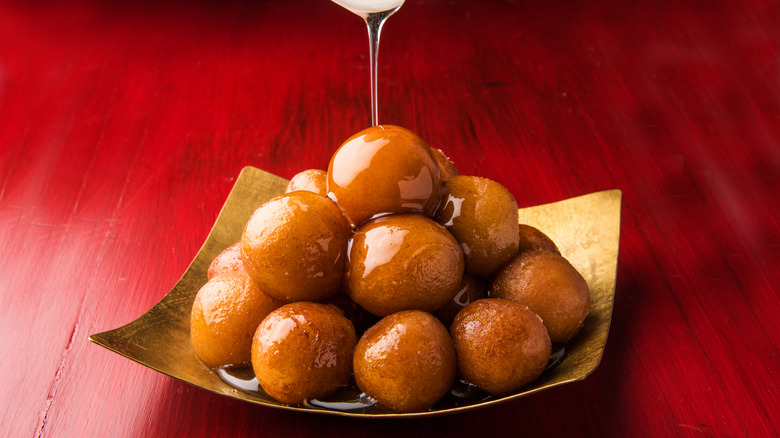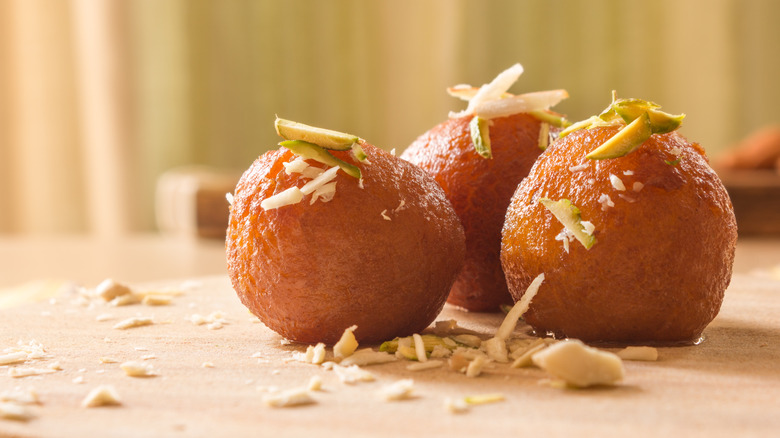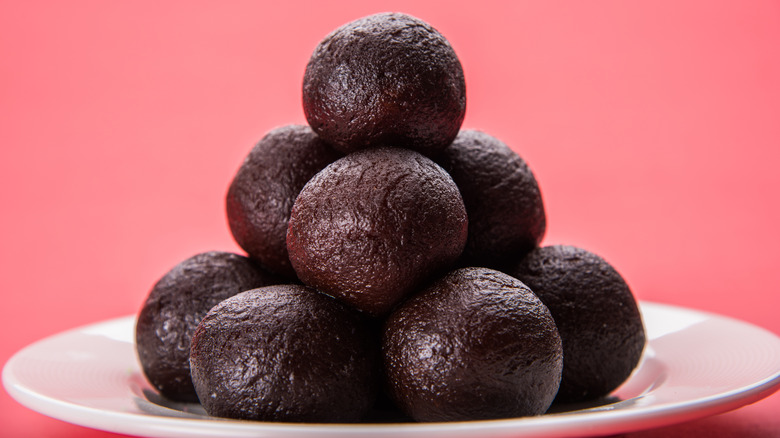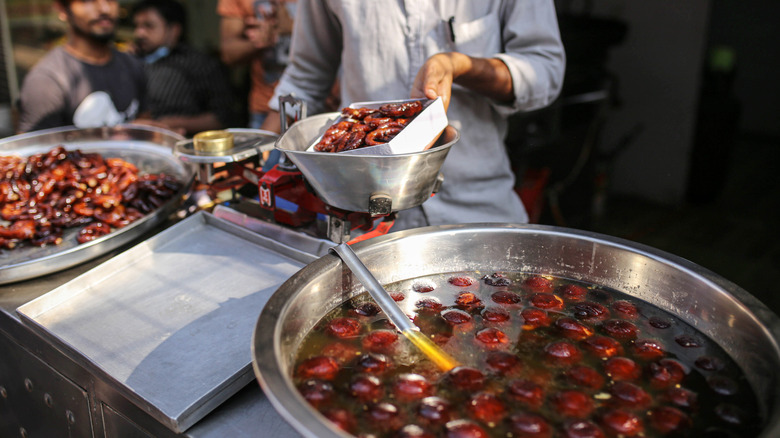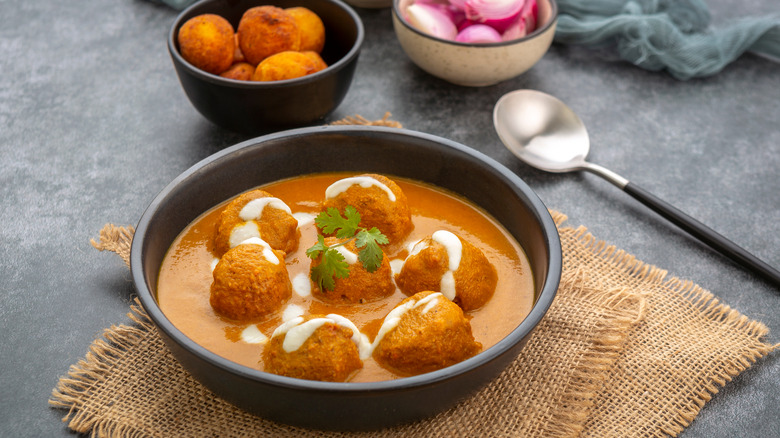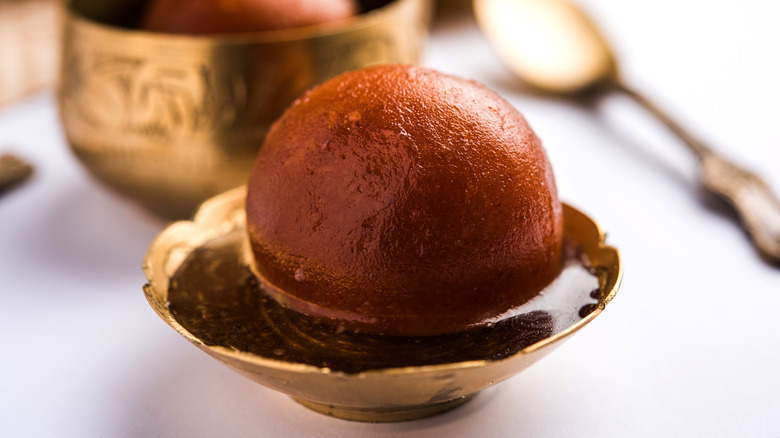What You Didn't Know About Gulab Jamun
If you are a fan of Indian food or have been a guest at a traditional Indian event, it's quite likely you have enjoyed gulab jamun, or at the very least, have heard of this treat. These sweet bites are usually the star of a dessert table at most Indian weddings, festivals, and celebrations — even birthday parties.
And if at any given occasion, gulab jamun is being served, you will probably be able to spot a bunch of people make a beeline for a piping hot fresh one. Who can blame them? These milk-based deep-fried donuts dripping in warm sugar syrup and spiced with tons of cardamom, saffron, and rose water (via Serious Eats) are totally worth fighting for.
There's so much to know about gulab jamun — how to make them at home, where to find them at your nearest store, and the history behind them that make them more than delicious — but also quite fascinating, too.
There are many theories about where gulab jamun comes from
Gulab jamun has long been presumed to be an Indian dessert, created around the medieval period, probably because of its immense popularity in the country (though neighboring Pakistan and Sri Lanka also have their own variants). But, its history and where the first one originated is still a matter of dispute. What most can agree on is that the name gulab jamun is of Persian origin, according to Medium. In Persian, 'gol' means rose and 'ab' means water, which directly refers to the use of the rose water that is used to make these dessert bites.
According to Times of India, there are claims that gulab jamun traces its origin to a very similar Arabic dessert called Luqmat-Al-Qadi that was first brought to India when the Mughals invaded the country. In another theory, Times Of India suggests that the sweet treasure as we know it was an accidental invention made by the royal chef for Shah Jahan, a Mughal emperor, who was inspired by Persian and Turkish desserts bamieh and tulumba, both similar to gulab jamun in terms of ingredients, flavor, and texture. Medium also notes a well-known theory that the dish was created by a Sikh chef, Sajjan Dhillon, who crafted it for the then-ruler of Punjab.
No matter its origin, though, it's safe to say that whoever invented gulab jamun was a genius.
There are regional variants of gulab jamun across India
Depending on the exact location in India, there are slightly tweaked and highly localized versions of gulab jamun that go by completely different names. In Kumbakonam, a town in the southern Tamil Nadu state of India, the 100-year-old family-run shop Kumbakonam Murari Sweets invented a dry version of the dessert (via the official website). The "dry jamun" is comparatively smaller in size, has a crispier outer covering, and is dusted with powdered sugar. This version of the gulab jamun can last for about a week outside the refrigerator, according to The Better India.
Also according to The Better India, there's another close variant known as kala jaam or kala jamun that is blackish-purple in color (as compared to gulab jamun's dark red or light brown hue). That's because the recipe for kala jamun calls for extra sugar in the dough and that excess, coupled with frying at a higher temperature, gives this treat its distinct color and crisp crust.
There are also variants of gulab jamun in the region Kolkata. One is called pantua, which is a tinier version stuffed with sugar cubes also known as mishri. The other is known as ledikeni and has more of a cylinder shape – rather than the milk solids traditionally used, it's swapped for an Indian cottage cheese known as chenna (via NDTV Food). According to The Better India, a popular sweet shop in Kolkata founded in 1826 by the name of Bhim Chandra Nag is behind this version. It's said that the shop was called upon by Lady Canning, the wife of Governor-General Lord Charles Canning (who later went on to become the first Viceroy of British India) to prepare a special sweet. It was so loved by her that the locals started calling the creation ledikeni, a mispronunciation of Lady Canning's British name.
How gulab jamun is made
While these sweet treats can be found at most Indian restaurants or sweet shops, there's also ways you can make them at home too. It's basically another iteration of fried dough with some special care. Per Serious Eats, the first thing you'll need is the milk solids, aka a dried milk known as khoya. While you can prepare it at home by simmering the liquid until it evaporates, it might be easier to buy a block at a specialty grocery store. Or, as the writer suggests, simply buy some non-fat dry milk next time you're on a shopping run. You'll also need a bit of heavy cream to add to the mix.
In order for the balls to hold their shape in the fryer, you'll also need a bit of flour. Serious Eats recommends semolina because it has a larger grain and prevents too much gluten from forming to keep the final product more tender. For a cooking fat, the article recommends ghee (which can add a nice caramel flavor) or grapeseed oil.
And then there's the syrup! All you need to do to make this very important final touch is combine sugar and water in a pan and then add the flavorful spices of cardamom, saffron, and cloves — add the integral rose water at the end since it's sensitive to heat. Just note that to get the best tasting gulab jamun, you'll want to soak the balls for four hours at least in the syrup but even better overnight. You can then simply warm them up when it's time to serve the dish.
The savory version of gulab jamun
While most know gulab jamun as the deep-fried donut holes soaked in sugar syrup that are meant to be eaten as a sweet dessert, that's not the only option. In Rajasthan, a northwestern state in India, gulab jamun is often mixed with spices and eaten as a savory dish (via Curry and Vanilla). Known as gulab jamun ki sabzi (gulab jamun vegetable), the dough balls are deep-fried and then immersed in a tangy and spicy curry instead of sweet syrup. This savory take happens to be a popular main course dish in Jodhpur, a city in Rajasthan well-known for its spicy curries (via NDTV Food).
Despite its popularity in this region, the very existence of a savory version of gulab jamun is so shocking that, a few years back when a Twitter user posted a picture of it, it turned out to be quite the food scandal, right next to pineapple on pizza!
There's an actual gulab jamun highway
With so much love for this traditional dessert, there is even a half-kilometer stretch of highway in India dedicated to the beloved gulab jamun. According to Times of India, it's located along the Delhi-Shahjahanpur-Lucknow National Highway 24 near a village called Michaelganj, in the state of Uttar Pradesh. The patch of land is home to more than 100 shops selling gulab jamuns. While the highway may be a secret to the rest of the world, local motorists know of it and make frequent stops.
A more bizarre fact that Times of India points out is that most shops selling gulab jamuns on this highway go by the same name — Mashhoor Gulab Jamun Ki Dukan (Famous Gulab Jamun Shop). No one really knows how the name came to be, however, a popular story claims that it all started when a man set up shop on the road in 1941 to sell his treats. While everybody else was mixing milk solids (khoya) and flour to make their gulab jamuns, this man only used milk solids, which made him stand out and become quite popular. Even today, most shops on the highway use his secret recipe.
